Perfecting my dosa recipe and method hasn’t been easy. It took a lot of experimentation, but finally I have the best dosa batter recipe and method for you. Read on to learn hot to make the perfect dosa-idli batter recipe, a dosa grinder giveaway, and your questions about dosa and idli batter answered by the experts!
Dosa, Idli Dos and Don’ts
Do use a hot griddle for dosas
Do use your hands to mix the ground batter
Do use whole urad dal (urad gota)
Do use a wet grinder or other similar heavy duty grinder/blender for the batter
Do place the batter in 80-90 degrees F for fermentation
Do experiment with various types of rice and urad dal to find what suits you best
Don’t pour dosas using cold batter
Don’t make dosas on an unseasoned pan (see recipe below for the onion trick)
Don’t use poor quality rice and dal
Don’t use an air tight lid when batter is fermenting
Your Dosa and Idli Batter Questions Answered by the Experts
Ive talked to several people about the art and science that is dosa-idli making. For this post, we have two of the most knowledgeable people on this topic to answer your idli, dosa questions.
Chef KN Vinod, is an award winning restaurateur who runs three of Washington DC’s favorite Indian restaurants Indique, Indique Heights and Bombay Bistro. At his restaurants, Chef Vinod regularly hosts celebrities and politicians including (KR Narayan and Hillary Clinton!). Chef Vinod blogs at http://chefvinod.typepad.com/. You can also find him on twitter and facebook. For today’s Q&A, Chef Vinod has elicited the help of his friend, and food scientist Dr. Danny Chawan.
Ms. Andal Balu is the owner of Atlanta based Inno Concepts, a company which sells kitchen appliance for Indian cooking. Mrs Balu is a successful business woman, gourmand, and America’s expert on dosa/idli making. Inno Concepts is the generous sponsor of today’s grinder giveaway.
My idli and dosa batter doesn’t fermentation properly. I let the batter sit in the oven with the light on overnight and it is completely unchanged even 10 hours later. Ive tried everything. Help!
Andal Balu: Use the soaking water to grind the rice and dal for proper fermentation. You have to mix the batter with your hand. If you mix it with ladle, it may not ferment right (body heat from your hands helps kickstart fermentation). Also cover the batter with a lid that fits loosely - do not use an airtight lid.
Chef Vinod: Fermentation is always a problem in colder places. Our modern living with air filters etc. also inhibits the capture of wild yeast from the air. Sometimes indoor air, particularly in winter with all the doors and windows shut will be low in air borne yeast cells. When all else fails, I would recommend using some yeast. Use half teaspoon in half cup water and a teaspoon of sugar to kick start yeast growth. Add to a gallon of batter.
Sala’s note: If you’ve tried everything, you might want to change your brand of rice and dal and see if that does the trick. Poor quality ingredients = poor quality fermentation.
In cold climates, place batter in an oven with the light on for warmth. Leave a note so no one turns off the oven!
What proportion of rice and ural dal do you personally use?
Andal Balu: I use the same proportion for idlis and dosas. 5 cups parboiled (idli) rice, and 1 cup whole urad dal (gotta). I make idlis with this batter the first day, dosa on the second, and uthappams on the third day.
Chef Vinod: At the restaurant we use 4 cups long grain rice, 1 cup parboiled (idli) rice, 1 cup urad dal, and a little methi seeds
Sala’s note: Everyones recipe will be different because quality of rice and dal used, quantity of batter made, and temperature all affect the ratio. Use these proportions as a guideline and then experiment.
Should I grind the rice and dal separately or together?
Andal Balu: Separately. Grinding dal separately will make it fluffy, resulting in excellent fermentation. It will also volumize the batter when fermenting which is important for fluffy, soft idlis.
What consistency and texture should my ground dosa and idli batter be?
Andal Balu: Grind dal till it is very soft and foamy. Also grind the rice till smooth. Add enough water to the batter so that it is thick, but when you scoop it in your hands, the batter falls through your fingers. This is what I do for both idli and dosa.
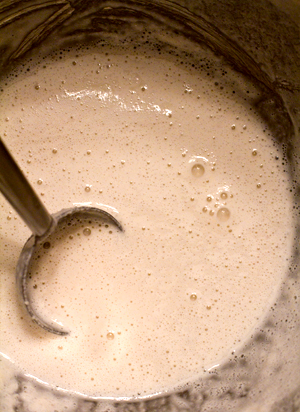
Does is matter if I use tap water or filter water for soaking and grinding?
Chef Vinod: If your tap water is highly chlorinated, it could inhibit fermentation. In this case, use filtered water.
Why do we use fenugreek or methi seeds in dosa-idli batter making?
Chef Vinod: Methi seeds contain compounds high in beta-glucans. They help hold carbon dioxide, which makes idlis fluffy and soft. Methi seeds also give viscosity to the batter.
If I rinse the dal, will it take away the necessary properties to ferment?
Chef Vinod: Washing is done to remove any dust, and impurities from the dal and rice. Althought some old time cooks soak the dal and rice without rinsing and wash just before grinding.
How much salt should I add to my dosa and idli batter?
Andal Balu: About 1/2 teaspoon for one cup of dry ingredients (rice + dal) plus more according to taste. Adding enough salt is important for proper fermentation.
How can I get good textured idlis at high altitude? What are the adjustments for altitude?
Andal Balu: The rice needs to be ground finer so it can cook faster at higher altitudes. If the rice is coarse, it will take longer to cook and will feel gritty in the mouth. Make sure a warm temperature is maintained when batter is fermenting.
Chef Vinod: I turned to Dr. Chawan for this. He says changing the proportion of dal and rice for higher altitudes isnt necessary. Fermentation is done by yeast, and yeast grows in high altitudes as well, and produces carbon dioxide which is the key component of making fluffy, soft idlis. Pay attention to the fermentation temperature; make sure your batter is in a warm place. A little glucose or corn syrup will also make your batter rise better.
My dosas always turn out dry and brittle, what am I doing wrong?
Andal Balu: Check the consistency of the batter – is it too thick? Check the temperature of the batter – make sure it is at room temperature, and not straight out of the fridge. Make sure that the pan is hot enough when you pour the batter. Check it by splashing couple of droplets of water on the pan and it should sizzle.
Chef Vinod: Two scientific reasons. 1. Not enough dal in your batter. Protein in dal is responsible for the softness. Try increasing your dal proportion. 2. Amylopectin in rice. According to Dr. Chawan, there are two kinds of starches present in rice and grains – Amylopectin and Amylose. If the rice is low in Amylopectin and high in Amylose it can cause the dosa to be dry and brittle. Sala’s note: Try experimenting with different brands of rice.
Ok, but there is no way I can determine the chemical composition of a bag of rice at the store. Is there a quick fix for dry and brittle dosas?
Chef Vinod: As a quick fix, if you have some tapioca flour handy, Dr. Chawan recommends trying to incorporate some into the batter as it is very high in Amylopectin. I have not personally tried it.
My idlis are pale yellow. How do I get white idlis?
Andal Balu: If the ground batter does not ferment properly, the idlis will be yellowish (see the question and answer on fermentation). Also make sure the consistency of the batter is right – once the urad and rice batters are mixed, take the batter in your hand, it must fall freely back into the vessel.
Chef Vinod: If your batch of urad dal has been contaminated with immature urad beans or partially germinated beans, this will produce some enzymes which will cause idlis to become yellowish or pinkish. Sala’s note: Try a different brand of dal.
I would love some tips on how to make paper thin, crispy dosas
Andal Balu: Grind the rice fine. Don’t use extremely thick batter. Use an iron skillet for best results. Bring refigerated batter to room temperature before making dosas. You can take it out of the fridge ahead of time. Or you can heat some water in the microwave and add to the thick batter to make it thin and to bring it to the room temperature. Between dosas, grease the tawa or skillet lightly with oil and then pour the batter. Add extra oil after the batter is poured on the skillet.
Sala’s note: I add chana dal (soak 3 tablespoons of channa dal with every cup of urad) for super crispy, golden, restaurant style dosas.
How do you get the nice golden color you seen in restaurant dosas?
Chef Vinod: Add a little besan (gram flour) in very less quantities that you cannot make out that besan has been added. OR, add a little sooji (cream of wheat) to make the dosa really golden and crisp. This again is done in very less quantities that you cannot make out.
Andal Balu: You will get nice golden brown dosas if you bring the batter to room temperature. If you use the cold batter, the dosas will stay white.
Sala’s note: I add channa dal (soak 3 tablespoon for every cup of urad dal) for golden colored dosas.
Why are my idlis hard and rubbery? How do I make soft and fluffy idlis?
Andal Balu: Keep four thing in mind for soft, fluffy idlis.
1. proper fermentation (see earlier questions)
2.proper rice:dal proportion
3.don’t overcook idlis, this will make them hard. Steam idlis for about 12 minutes if using a conventional idli steamer, and 15 minutes for an electric one.
4.never pressure cook idlis
What is the proper way to eat a dosa, what are the accompaniments, what do you dip it with? Is there a dosa etiquette?
Andal Balu: There is no dosa etiquette. Enjoy it however you want. Side dishes recommended – idli chilly powder, coconut chutney, tomato chutney, coriander or cilantro chutney, yogurt, Chinese garlic pickle, potato masala, sambar…possibilities are endless!
Chef Vinod: Dosa is made and served differently from region to region in India – so I would not say that a particular way is right or wrong. Most places in south India serve dosas with sambar and coconut chutney.
Sala’s note: Serve yourself a dosa on your plate. Pour sambar into cups, if they are available. Serve chutney, dosa or idli podi (also called gun powder) and potato masala on the plate. Tear off a piece of dosa and dip it into any combination of the sambar, chutney, podi and or potato. Lick your fingers, and enjoy ![]()
The Perfect Dosa Recipe
Serves about 8
1 cup sona masuri rice (or similar medium grained rice)
1 cup idli rice (parboiled rice)
½ cup whole urad dal (skinned black gram)
½ teaspoon methi seeds (fenugreek seeds)
Salt 1 teaspoon
Special equipemt: a wet grinder. This is a heavy duty grinder that is perfect for dosa and idli batter. You could use a blender instead, but the results wont be the same.
Place the rice in a large bowl. Place the dal and fenugreek seeds in another large bowl. Wash the rice with room temperature water. Drain out the water, and fill the bowl with more water, so that the water is about 2 inches above the rice.
Do the same with the dal and fenugreek – wash, rinse, and fill with water. Let rice and dal soak for about 6 hours.
The dal should now be swollen, and the rice will be easy to break with your fingers.
Pour about 2 tablespoons of the dal soaking liquid into a wet grinder. Turn the grinder on. Then, using your hands, scoop the soaked dal, allowing excess water to drain back into the bowl. Add dal to the grinder, hand fulls at a time. Grind till the dal is fluffy and silky smooth – about 15 minutes (grinding time will vary depending on the grinder and quantity of dal). You should have fluffy clouds of ground dal – think liquid marshmallows.
Sprinkle a little soaking water into the grinder as and when needed, to move the batter along. Turn off grinder, and scoop the ground dal using your hands and put it into a large (4 quart) bowl.
Now grind the rice (no need to wash the grinder). Add 1 cup of the rice soaking liquid into the grinder and turn it on. Add the rice to the grinder. The rice should be ground to a smooth, but ever so slightly gritty batter – about 20 minutes (will vary depending on the grinder and rice). Sprinkle water in the grinder as and when needed.
Using your hands, scoop the rice batter into the bowl with the dal. Add salt, and stir gently using your hands. You should now have approximately 2 quarts of batter.
Cover the bowl loosely, either with a large tea towel, or a lid. The lid should not be air tight.
If you live in a warm climate leave the batter over night in a warm place (about 8 hours) to ferment. Ideal dosa idli batter fermentation temperature is around 90f or 32c.
If you live in a cold climate, turn on the pilot light of your oven. (do not turn on your oven!). Place the batter bowl on the lowest rack, farthest away from the light. The light will give the batter enough warmth to ferment. Leave the bowl in the oven for about 10 hours for dosa batter to ferment. Sometimes, the batter may take up to 18 hours to ferment in colder climates.
The fermented batter should be frothy, and almost doubled in volume. For this recipe, you should land up with at least 3 quarts of fermented batter.
If the fermented batter is too thick, add a little water. For dosas, the batter must be of pouring consistency, but not runny.
Heat a 9 inch nonstick skillet on high heat. Sprinkle a few drops of water on the skillet. The water should sizzle and evaporate away on the count of 4. This means the pan is hot enough to make dosas.
Cut a small wedge from an onion. Stick a fork into the onion (See photos above). Add a drop of vegetable oil to the hot pan, and spread the oil around, using the onion. (Just a drop of oil will do for a non-stick pan.)
Now pour a ladle (1/4 cup) of batter onto the hot pan. Using very little pressure, swirl the ladle in concentric circles, to spread out the batter (see photos).
When the batter is fully spread, spray or drizzle a few drops of vegetable oil all over the dosa.
Cook on medium-high heat till the bottom side of the dosa becomes lightly brown.
At this point, you can fold the dosa over in half, or roll it into rolls like ive done, and serve. (For extra crispy dosas, flip the dosa over, and lightly brown the other side).
Taste your first dosa, and adjust salt in the batter if needed.
Serve with sambar and tomato chutney.
———————————————————————————————————————–
This giveaway had ended. We have a winner!
Please contact me to claim your prize! veggiebelly@gmail.com
Win an Ultra Pride Plus Wet Grinder!
1.25l capacity
Voltage 110V AC 60Hz
Sleek design, easy to clean
Kneader attatchment for dough
Perfect for grinding dosa, idli, vada batters
More features here
Ive had mine for 6 years and love it ![]()
** When you entered the giveaway if you checked the ‘send me a coupon’ option, iNNo Concepts Inc will send you a coupon for $10 off Ultra Pride Plus grinder plus a free gift worth $20 or $20 off all other larger sized Ultra grinders plus a free gift worth $20. You can use this coupon between April 9th and April 15th. US & Canada shipping only. No cash redemption.
![]()

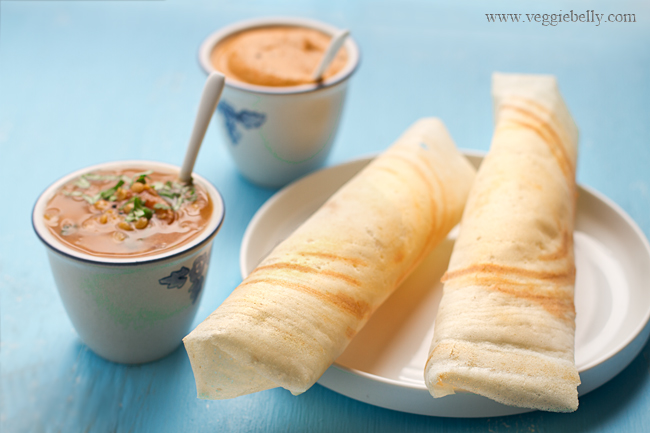
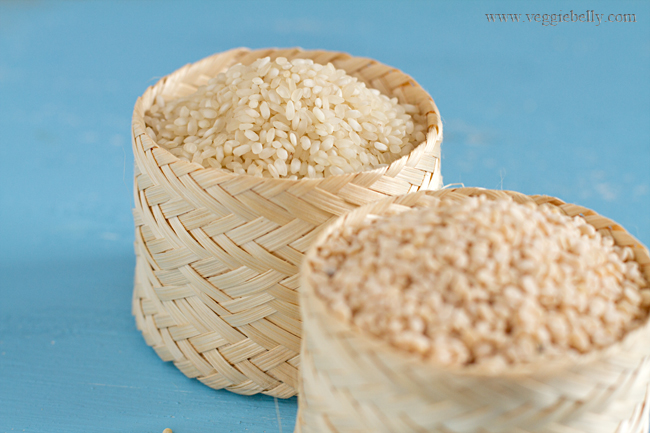
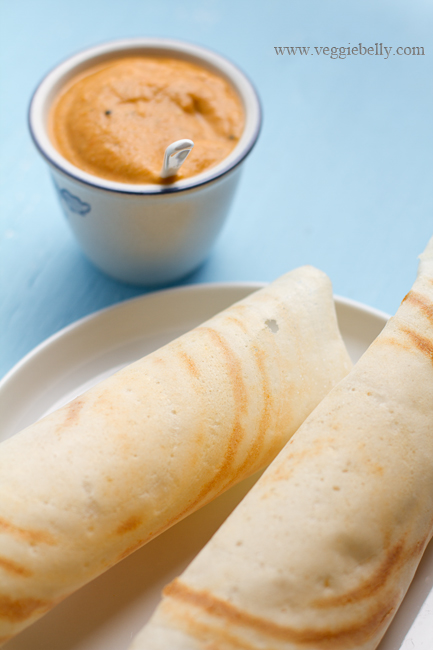
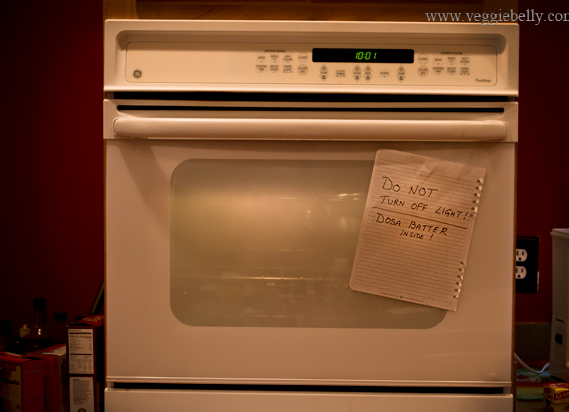
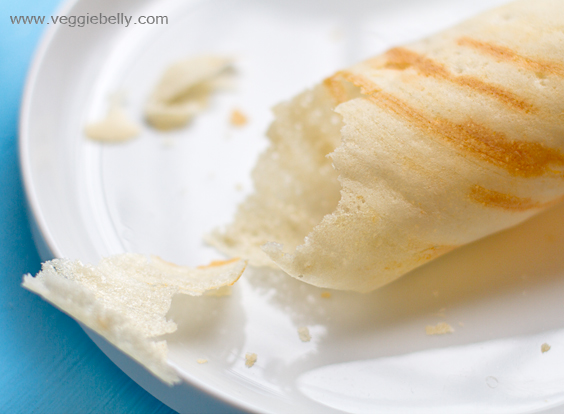
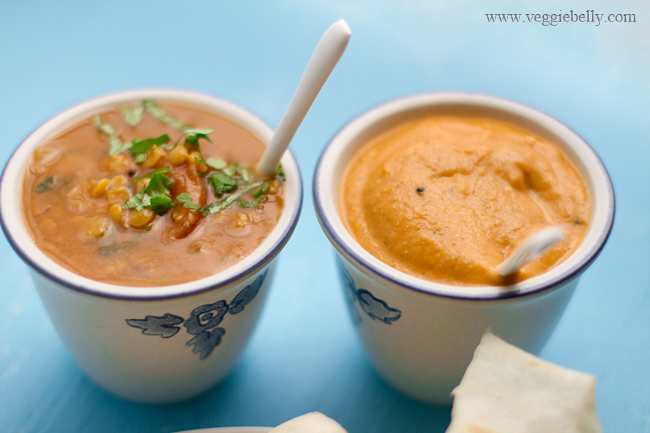
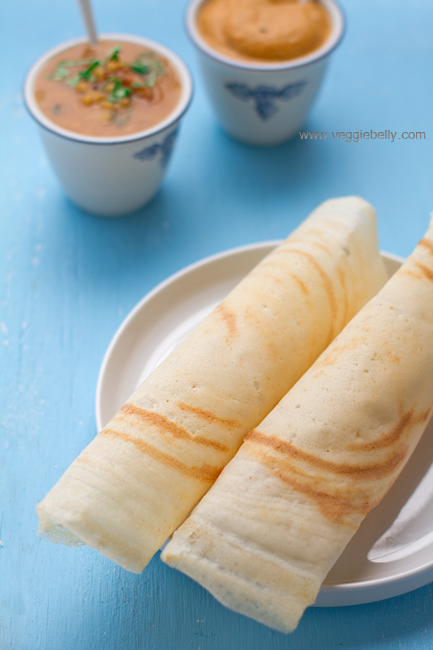
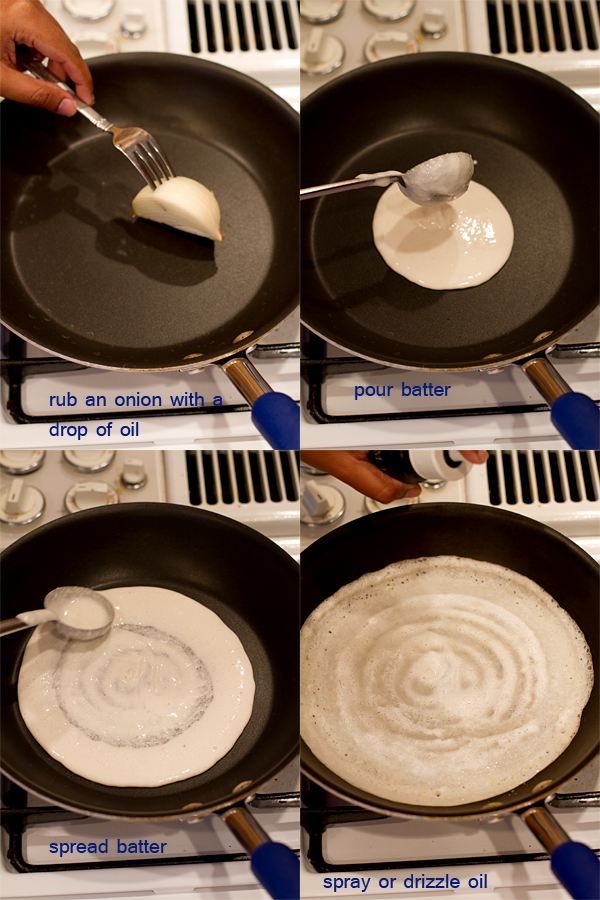
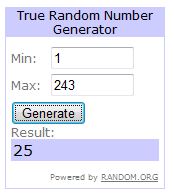
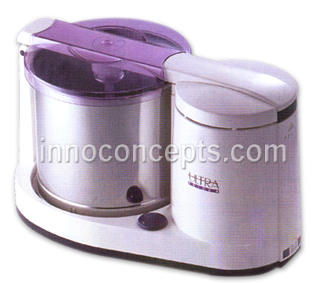
Thank you for this post! I love Dosa, but they never turn out quite right for me.
[Reply]
Nice post! I shared it in FB too.
[Reply]
This was super duper useful! I always try different proportions of rice and dal but yet to try different kids of rice. Planning to try that next. I’ve had the same grinder for almost a year now and absolutely love it!
[Reply]
Wonderful post and very useful , informative for the beginners.. the pictures are just awesome which is always in ur space the note in the oven is cute
the note in the oven is cute 
[Reply]
Sala @ Veggie Belly Reply:
March 29th, 2011 at 12:53 am
I started putting the note on because the last time, the energy saving person in the house turned off the oven light and i had totally flat dosa batter (it was winter). Sometimes I also write “If you want dosas for breakfast leave the light on!!”
[Reply]
Great post !!!

I think it needs a bit of practice to make thin brown dosa apart from all the precautions . I have ground the batter in a mixie all my life and it comes out great every time. Also i like my dosa with basmati rice ( the basmati loving north Indian you know;) ) , so that can be tried as well .
Your chana daal tip i have to try for sure , normally i use 1 cup of urad daal for 4 cups of rice for dosa and 2 cups of basmati rice … 1 cup of parboiled rice and 2 cups of urad daal for idli ( as told by a Tamil friend of mine ) and it is great to my preference….this post reminds me of my early days with cooking when i used to be so confused about the ratios
Also , i like that every home , every restaurant has it’s own brand if dosa, so it’s always great to have a new kind of dosa
[Reply]
Wow, this is just absolutely excellent information. I’ve tried a few times over the years to make my own dosa/idli/uttapam, and they have never turned out quite right, and I’d just about decided that I’d settle for the GITS mixes when I can’t get to a restaurant for my fix. You’ve given me new hope that I could actually make really good ones, and I can tell from your pictures that yours are excellent.
[Reply]
Wonderful tips! My mom said the same thing Ms. Andal Balu mentioned. i.e to not throw away the water the dal is soaked in. And cast iron skillet makes a big difference too.
Could I please be entered to win this wonderful toy?!
My experimentation continues, not entirely satisfied with meenakshi ammal.
[Reply]
What a beautiful post! I’ve never had dosas, but I’d love to try that fabulous speciality. I love the note on the oven… ;-P
Cheers,
Rosa
[Reply]
Thank you for bringing us this wonderful post Sala, its nice to find all the tips and tricks in one place. Idli/dosa batter has been a trial and error process for me. Like Ms. Balu mentioned, I use the same batter for both and make idlis the first day, dosa the next and the rest of the batter, if any, then gets turned into uthappam/paniyaram For crispy dosa’s the channa dal tip has worked for me but for the spongy/soft dosa lovers a handful of poha/flattened rice flakes soaked along with the urad dal seems to do the trick for me.
For crispy dosa’s the channa dal tip has worked for me but for the spongy/soft dosa lovers a handful of poha/flattened rice flakes soaked along with the urad dal seems to do the trick for me.
[Reply]
Such a informative post…And sure very useful too
[Reply]
I use one cup urad dal for 2 cup rice ..shall try your proportion …and that’s spread looks yum …
[Reply]
Wow Sala, this is an absolutely excellent post, thank you. I have a recipe for dosai but every time I read it I get confused. You’ve answered all my questions and then some! Now to pluck up my courage to make some. I haven’t had idli in a looooong time. Btw, in Malaysia, the dosa and idli are served with a wet coconut relish/sauce. Do you know how to make that? I would be so grateful!
(I am not eligible for the giveaway, good luck to everyone else )
)
[Reply]
Andal Balu Reply:
April 1st, 2011 at 6:14 pm
Hi,
You can not win the grinder. But if you register, we can send you a special coupon and you can use it at any of our stores for your purchases: (We deliver around the world)
http://www.innoconcepts.com
http://www.eShubham.com
http://www.navarathri.com
Andal Balu
[Reply]
Subha Chakrapani Reply:
November 1st, 2011 at 6:13 pm
Hi, Can you please e-mail me a coupon for the purchase of Ultra Pride+ grinder.
Thank you,
Subha Chakrapani
[Reply]
Megha C Reply:
January 15th, 2012 at 10:00 pm
Hello, I want to buy the Pride + from your website. Can you please send a coupon also? Thanks!
[Reply]
Andal Balu Reply:
May 28th, 2012 at 9:21 pm
Please send us an email to info@innoconcepts.com and we will email you the coupon.
Thanks so much for posting this recipe! I have been trying for a while to make the perfect dosa!
[Reply]
Excellent post Sala. Very very helpful !!
Thanks
Suparna
[Reply]
I want that wet grinder!!! I’ve been meaning to buy one for the past three years, it would be lovely to win this now I’m a true tam bram at heart and cannot survive without my idli-dosa fix. And I hate my blender
I’m a true tam bram at heart and cannot survive without my idli-dosa fix. And I hate my blender 
Shared this on facebook too!
[Reply]
Lovely post Sala.
We are HUGE dosa fans at home and I usually use 1: 2 3/4 or 3 Lentil:rice ratio and that too works fine.
Lat year I invested in an electric griddle, worth every penny (hehe, i got it in the thanxgiving sale, mail in rebate , so mine cost me $10!!) and it makes perfect dosas and 2 at a time:)
I have dreamed and dropped many a hint to the hubby for a wet grinder, hopefully he will understand and gimme!
[Reply]
What a fantastic post! I’ve always wanted to make dosas and now I feel much more equipped to try it
[Reply]
Thank you so much for the wonderful post. Keep up the hardwork.
[Reply]
LOVELY!!
[Reply]
I’m starting to try more Indian food, and really loving the results! I have urad dal in my pantry, I could use a blender to get started on some dhosas!
[Reply]
Sala,
Love those Dosas looking gorgeous against the blue background. Lovely pictures (as usual). Got to make some for me now!
Q&A section is one of a kind and truly helpful.
Btw, ULTRA grinder is my personal favorite and I own one too.
[Reply]
Great post. I think I have only tried making dose once and it was a failure! This has helped me want to try again though!
[Reply]
Sala, first time at your blog loved it,nice presentation and recipes
[Reply]
Wonderful post!!! Very informative. Wish i was eligible for the give away
[Reply]
Thanks for the helpful post! This helps in so many ways! And I just got the same wet grinder a couple of months ago and love it!
[Reply]
Dosa and sambar are the only good Indian foods I can cook (and I’m Guju). I loved this post and found myself nodding in agreement with the tips presented here. I recently bought an electric griddle to prep these on, but went back to cast iron (I’m glad the griddle worked for one of the posters here; mine never really cooked). This may be viewed as cheating, but I’ve tried adding a tbsp of plain yogurt to the idli batter for a tangier taste (it also helps with the fermentation). I’ve always blended the rice and dhal together, but will try them separately to see how it comes out. Lovely post – I came here from Foodgawker.
[Reply]
What an awesome detailed tutorial, Sala! And that grinder is a beast (in a good way!). Love your rice holders, too. Did you get them around here?
[Reply]
Sala @ Veggie Belly Reply:
March 31st, 2011 at 9:46 am
thanks yes the grinder is a beast, which is exactly why it is perfect for grinding rice and dal! i got the rice thingies in thailand
yes the grinder is a beast, which is exactly why it is perfect for grinding rice and dal! i got the rice thingies in thailand 
[Reply]
What a coincidence- I was just perusing the web for a wet grinder when I saw your give away- I posted a link on FB too!! Thanks for all the great info!
[Reply]
Thanks for including my question about altitude. I used 1:2 urad: rice in Bombay as that was what my friend’s Mom used. It worked in Chicagoland but not in Colorado. I use 1:3 or 1:4 depending on the season. I find it interesting that they said to use some sort of sugar – to feed the yeast, obviously. I think humidity plays a key role, too. It is very dry here and without any humidifying aids, it drops into single digits.
I’d love to be entered into the giveaway. Thanks!
[Reply]
Sala @ Veggie Belly Reply:
March 31st, 2011 at 12:03 pm
Thanks for your question, i hope the answers helped.
Te enter the giveaway, scroll up to the beginning of the post, and enter your email address.
[Reply]
You have such a passion for making dosa!!! It looks beautiful! I just wish I have the right equipment for making this! Thanks for writing such an educational and informative post!
[Reply]
Awesome tutorial. So many of my friends ask me how to make dosa. Will share your link with them. Loved the oven note. I write this note to my husband ” If you want good crispy dosa, stay away”
[Reply]
Shared in FB too!
[Reply]
Great tips for a perfect Dosa. I would recommend using a cast iron griddle to make them. I have been using it for a long time and the dosa`s turn out perfect. For restaurant style dosa, I add a little bit of rawa as mentioned.
[Reply]
I have had zero luck making my own dosas! Perhaps things’ll change after reading all these great tips?
[Reply]
wonderful set of FAQ’s on the art & science of dosai!! Thanks Chef Vinod & Ms. Balu…
Ms. Balu: nope I’m not throwing my hat into the ultra grinder giveaway ring, but I’m desperately seeking a replacement Jar for my preethi mixer (the smallest one for dry grinding) its undergoing a progressively expanding crack of the likes of the rift valley! could you share some information on how I could buy a new one please.. thanks!
[Reply]
This is a great post Sala. For a while I struggled with my dosa and just recently started getting better at it. I should try this recipe.
[Reply]
What a fantastically informative post and I loved the picture of the oven! The Q&A was very helpful.
I’ll be linking to this post from my blog.
[Reply]
I have one problem with dosa. when putting on pan, the batter sticks in a lumpy form on my ladle when i make the concentric layers. how do i avoid this? is my batter not fine enough?
[Reply]
Sala @ Veggie Belly Reply:
May 27th, 2011 at 10:29 am
are you trying to pour cold batter straight from the fridge? that may be the issue – cold batter hitting a hot pan. Also, try using the onion method on this post, that will keep the dosas from sticking. A non-stick pan will also help.
[Reply]
What an awesome post!!!! I have always wondered about the perfect dose recipe. First time here. Absolutely love ur space
[Reply]
I tried a recipe that did not include the fenugreek. It was very bland. A place in NY called “Hampton Chutney” makes great dosas, and that was my frame of reference. I will try this again, perhaps adding some fresh herbs at the end.
Thanks for all of this information – back to the kitchen for another try.
[Reply]
Thank you so much for the detailed instructions. Thank U
Thank U
I made idli’s using idli rava and used the ratio of idli rava:urad dal as 2:1. I followed the instructions for grinding the urad, mixing them and the time for each, from your blog. Amazing results! I got the best idli’s that I ever made.
[Reply]
Sala @ Veggie Belly Reply:
October 12th, 2011 at 10:47 pm
thats wonderful!
[Reply]
Very detailed post…awesome recipe!
[Reply]
Ok… I have fallen in love with crepes quite recently. However, DOSA crepes look so far out of my reach right now! However, I would love to try making one…
[Reply]
still not coming right`. gonna keep on trying. can rice seem the problem. Definitely not using batter from fridge. as i make the concentric layers on the pan, it doesn’t spread very nicely. i get a thick like so jee build up on my ladle.please help. is my consistency not right.
[Reply]
Sala @ Veggie Belly Reply:
October 30th, 2011 at 1:18 pm
your pan might be too hot. also make sure you rub the pan with a sliced onion or paper towel and a drop of oil. this will season the pan. sometimes the first few dosas will stick and then as you keep going, they will come out nicely.
[Reply]
Polly Reply:
December 25th, 2011 at 7:04 pm
I have the same problem. Warm batter, different consistencies, all different temperature pans, all kinds of pans, non stick and regular. The second the batter hits it lumps up and the dosa comes out too thick and not crispy. I think after reading this, that it’s the lack of fermentation. My batter isn’t rising nearly as much as it says here (first recipe that explained that!) and I think my batter isn’t airy enough. I had no idea how important warmth was to this process, I’m trying this in a very chilly new England kitchen. So onto the oven idea! Thanks so much for such a great resource!!
[Reply]
really very very nice guidance
[Reply]
please offer a printer friendly version of this blog. the pictures take up a lot of room when i try to print this for future reference.
[Reply]
Sala @ Veggie Belly Reply:
January 4th, 2012 at 1:00 am
i am working on that, in the mean while you can cut and paste the text onto a word document, and print that
[Reply]
I always wanted to make Dosa from home made batter…but couldn’t..I followed ur recipe and guess what..? it worked..! My hubby loves Dosa and I was really happy to make HOME made dosa for him..!
Thanks again..!
[Reply]
I am from Bangladesh and want to know what is URAD DAL, I asked lot of people what is this URAD DAL and in my country what is local name of this URAD DAL but can’t find any proper answer. Can any one please help me out?
Regards
TANVIR
[Reply]
Andal Balu Reply:
May 28th, 2012 at 9:26 pm
In Indian English, it is called Black gram. The skin in black in color and the lentil inside is yellowish white. It is also one of the main ingredients of East Indian (oriya and Bengali or Assamese) pitha (from wikipedia)
[Reply]
BasharBaset Reply:
December 11th, 2012 at 12:58 am
Urad Dal is MASH KOLAI DAL in Bangladesh.
[Reply]
No words to express my gratitude. Though I am tax professional I am very interested in dosas, and still experimenting and researching. There is no end to knowledge or vidya. There is lot of secret in Parboiled rice. Wish you all the best!
[Reply]
I have made dosa batter as per the guide lines. But it just doesnt spread when I try to put a dosa. Its too sticky, when I add water its too thin to spread. Please advice.
Cheers
Divya
[Reply]
Sala @ Veggie Belly Reply:
February 12th, 2012 at 9:15 pm
does the dosa stick to the tava? that means the tava is too hot.
[Reply]
Hi,
I have couple of question and I couldn’t find an answer for that so far.
Before going to the question, let me tell you in what temp I live in. The max temp I have here is 10 C deg at the moment and goes upto 0 deg C during night time.
I am a believer in whole grains and I always buy black gram dal WITH skin (whole one – not the split one). Now my 1st question is, is it possible to make idlli or dosa with back gram dal (with skin, whole version)? To be honest I am not bothered about the colour of my idlli or dosa
2nd question is, that it takes atleast 1 day to soak up the whole gram completely. By that time couple it will start to germinate as well (not all). Is it fine to use even the germinated one for idlli / dosa batter.
I will really appreciate if you could find me the answer for these questions. I have never got any answers so far for these 2 questions.
Kind Regards,
Aarthy.
[Reply]
Sala @ Veggie Belly Reply:
March 8th, 2012 at 7:32 pm
You can use urad dal with the skin for dosa. But you may have to experiement with the rice:dal ratio.
You really dont have to soak the dal for an entire day. Have you tried doing it just for 8 hours?
In any case, if a few dals sprouted, you shouldnt have any problems. Just call it sprouts dosa!
[Reply]
Andal Balu Reply:
May 28th, 2012 at 9:30 pm
We have made idlies with whole urad – it has more nutrition and fiber. the color was little off (not pure white like regular idli) but the taste was very good. We also made idlies with germinated urad dal. It was also very soft. I used same 5 rice to 1 urad ratio.
[Reply]
Help! I received an Ultra Pride + wet grinder for Christmas (ok, it was ordered for Christmas and it JUST arrived this week) I’m making dosa batter this weekend for SURE but what else should I make?
[Reply]
Sala @ Veggie Belly Reply:
March 14th, 2012 at 5:20 am
You can use the grinder for vada batter as well.
[Reply]
Kara Reply:
March 18th, 2012 at 4:12 pm
Chutneys? curry pastes?
[Reply]
I realize that this is an old post, but I wanted to let you know that I really appreciated the question and answer section! Plus, I now feel confident that I can make dosas, a new love of mine. Thank you!
[Reply]
Sala @ Veggie Belly Reply:
March 15th, 2012 at 12:43 am
glad it was useful
[Reply]
Do you recommend using the whole urad dal (with skin) or the split urad dal without skin?
Thanks
[Reply]
Sala @ Veggie Belly Reply:
March 15th, 2012 at 10:42 pm
without skin is best
[Reply]
Very useful post.
I always add a fistful of poha( beaten rice) for every every cup of rice for both idli and dosa. this makes the idli and dosa soft and gives a nice colour to dosa
[Reply]
To spread the dosa batter uniformly, make sure there is little batter left in the ladle when you are spreading. If the ladle is empty, ladle gets hot and dosa batter gets heat on both sides and it will not spread. When you leave a little dough in the ladle, the dough takes the heat and the ladle does only spreading job. Also try to spread it faster.
If you want to make a bigger dosa, pour one ladle of batter, then take some more dough in the ladle and then spread.
Try this tip and let us know how it turns out.
[Reply]
You can use the grinder for grinding moong dal for pesarattu. You can grind anything that is soaked and ground with water.
Also atta kneader is excellent for kneading the dough for chapathis, puris, parothas, cookies, pizza and more.
If you want to use it for coconut chutney, use only grated coconut.
[Reply]
when we soak the grain and then throw away the soaking water, don’t we lose nutrients? so how to maintain the soaking water with the nutrients in it? or perhaps there are nutrients in it?
[Reply]
sorry i wrote that wrong
when we soak the grain and then throw away the soaking water, don’t we lose nutrients? so how to maintain the soaking water with the nutrients in it? or perhaps there are no nutrients in it?
[Reply]
Sala @ Veggie Belly Reply:
June 19th, 2012 at 2:58 pm
I’m not sure, but the main reason to wash the rice and dal is to get rid of dirt!
[Reply]
Excellent! I was looking for a completely different pancake recipe and found your blog instead. I will definitely try this – I love dosas.
[Reply]
my problem is whenever the batter is poured for dosa it simply concentrate and sspils out with the running of the laddle
[Reply]
my batter simply gets concentrated and sticks out with the laddle as soon as it moves on the batter for making dosa
[Reply]
Sala @ Veggie Belly Reply:
September 4th, 2012 at 9:58 am
The pan might be too hot. Or it may not be seasoned properly. Try the onion and oil method, it will help the dosa not stick to the pan.
[Reply]
What should be the temperature of the griddle to make crispy dosas? Same for pesarattu?
[Reply]
I’ve just made and eaten these with sambar and hubby and I agree they are they are the best dosa we have ever tasted, better than previous recipes. Thank you!!! I use my vitamix to grind, it’s super fast and heats the mixture so starts off fermentation well.
[Reply]
Anand Reply:
December 7th, 2013 at 12:59 am
Dear Jen,
How much quantity do you use to grind in Vitamix? Did it overheat or did you get any burning smell or did you sight any smoke?
Thanks
Anand
[Reply]
Jennifer Reply:
December 16th, 2013 at 4:48 pm
I usually double this recipe and I grind the rice in 3-4 batches (urad dal in one) and then mix them by hand together in a bowl. I also add a handful, grind couple seconds, then another handful, grind some more, etc. I have never had smoke or overheating.
[Reply]
Sala,
Thanks and I made perfect Dosa with recipe.
[Reply]
Wow, thanks for the detailed tips! Gonna keep on my Dosa thing till I get it right. This post will help tremendously.
[Reply]
My Comments: 1. Use a yoghurt maker to keep the dosa / Idly batter to ferment in any climate. Typically, in about 8 hours to 10 hours, your batter will be well fermented.
2. Use a spoonful of starter, if you are in a haste to get the same results. That way, you will have your batter ready in 4 to 5 hours time. ( It is a good idea to keep the scraping of the batter in a small airtight container in the fridge, so that you can make better batter.
3. Dosa batter, you do not require any grinder at all! Mix 1 cup of Urad flour with 4 cups of rice flour. Add salt to taste. Add 1/2 tea spoon methi powder. add 1/4 tea spoon of pure sugar ( this gives the caramalisation of dosa and you can get that golden color. Never add too much of water to the batter for dosa. As you are using a fine flour of urad and rice, you must use minimum water in the batter. Now, your fermented batter you can spread paper thin and make the restaurant style dosas, any time.
Now for Idly, you need to grind only Urad dal. Soak it for about 20 minutes. Grind the dal with minimum water. Do not grind it for too long. I use a blender( under 40 USD) and grind for just 2 minutes. use 2 cups of Idly Rava ( This is rava made of par boiled rice specially meant for Idlies. You get this Idly rava in most Indian stores). No methi or sugar to be added.
Again, water to be just optimum. Never pour unnecessary water. I never touch the batter with my hand; it is neither hygienic, and can also contaminate the food with hundreds of harmful bacteria that reside in our hands.
Use the Yoghurt maker (this will maintain 110 degree Fahrenheit and your batter will be ready in 8 to 10 hours. Again, if you have a little starter, you can expedite the whole fermentation in under 5 hours.
I make yoghurt and dosa and idly batter al the time using my yoghurt maker. ( You can get a large sized one for around 30 USD in Amazon).
Now, You can use the Indian Pressure cooker for making Idly. Never, I repeat, Never use the weight while cooking idlies. It takes 2 minutes to boil water; cook with the lid on, but without weight at high flame for 4 minutes. then lower the flame and cook another 3 minutes. remove the idly set from cooker. Let it cool for 3 or 4 minutes then remove the idly with a flat spoon handle or knife.
Tip: use a drop of oil in the idly stand, clean with a tissue, this makes it non sticky and idly will be soft and pure white.
If you are making another batch of idly, wash your Idly stand ( inside and outside , wipe it dry, smear a drop of oil, clean with a tissue, before pouring the batter for the next batch).
I make Idly or dosa atleast 3 to 4 times a week. My blender is over a year and cooker is almost 12 years. The above formula works and whoever has tasted the Idly in my home always complimented us.
Hope this gives hope to any frustrated idly dosa fans, who could not make them at home.
If you need any help, feel free to write to me at ravee5@aol.com
[Reply]
Thanks for sharing delicious recipe Dosa. i love to eat it twice in a week at home or outside. really it is very tasty. palli chutney,coconut chutney are the best combination for dosa. even we can try chicken curry also. i need to try it.
[Reply]
You really should set the recipe in its own space for easy printing. I printed over 25 pages … pretty inconsiderate.
[Reply]
hi,
i tried ur recipe as per chef vinod,used 4:1:1,long grain:idli rice:urad dhal,
idli comes out sticky…can u plz guide me to get normal idli without sticking, i use blue ribbon long grain rice.
thanks.
[Reply]
Sala @ Veggie Belly Reply:
April 2nd, 2014 at 3:49 pm
You may need to use more urad dal. Try using 4:1:2. For idlis you can use all idli rice. Long grain rice can make it chewy sometimes.
[Reply]
Wonderful site, and answers every thing is bugging inside. thanks a lot
[Reply]